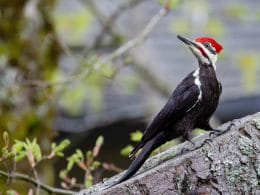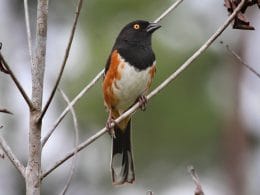Hawks are small, medium and large birds of prey and are fascinating and beautiful to watch, even if they can be a bit vicious when they hunt. But how can we tell if a bird is a hawk? In this post, we look at some identifying features of hawks and profile some of the more common species.

What is a hawk?
Hawks belong to the Accipitridae family along with eagles and kites. Hawks in the United States fall into 2 groups – true hawks and buteo hawks. In other countries, buteo hawks are known as buzzards. There are 20 species of hawk according to the American Bird Association and these include the Chinese Sparrowhawk and Crane Hawk, which are very rare vagrants. The hawks we will be considered are those most found commonly in America:
- Sharp-shinned Hawk
- Cooper’s Hawk
- Northern Goshawk
- Red-shouldered Hawk
- Red-tailed Hawk
- Common Black Hawk
- Hawaiian Hawk
- Harris’s Hawk
- Swainson’s Hawk
- White-tailed Hawk
- Zone-tailed Hawk
- Broad-winged Hawk
- Gray Hawk
- Short-tailed Hawk
- Ferruginous Hawk
The Shape of Hawks
While generalizations are often made about the size of hawks compared to other raptors, it is not really helpful. For instance, the largest falcon only has a slightly smaller wingspan than the largest hawk. Furthermore, the smallest hawk is smaller than the smallest falcon.
So, let’s consider shape.
The accipiter hawks are the Northern Goshawk, Sharp-shinned and Cooper’s Hawk. All the other hawks are buteo hawks.
Buteo Hawks

This is a Zone-tailed Hawk and you can clearly see that it has long and wide wings with a relatively short tail.
Accipiter Hawks

This Cooper’s Hawk is more slightly built with a longer tail.
Flight and Movement
The buteo hawks are usually seen over open areas, soaring and scanning for prey. The accipiter hawks are fast and sleek, searching for food in more forested areas.
Comparing to Eagles and Falcons
Now we have the hawk family sorted, how do we distinguish them from eagles and falcons?
Eagles

The Golden Eagle pictured above is easily distinguishable from any hawk. It is at least twice the size, even of the largest hawk. The Bald Eagle is even easier given its white head. The eagles also have huge tails and wings.
Falcons

Falcons are easily distinguishable from the buteo hawks as they are smaller, slimmer and overall more diminutive. It gets a bit trickier comparing falcons to the 2 smaller accipiter hawks. In general, however, we can say that the falcons tend to be darker or more varied of color. The Sharp-shinned and Cooper’s Hawks might look like falcons in shape and movement, but their plumage should give them away.
Let’s profile these accipiter hawks.
Accipiter Hawks
Cooper’s Hawk (Accipiter cooperii)

The Cooper’s Hawk is a slate gray on the back and has fine barring on an orange front. Its measurements are:
- Length: 14.6-15.3 in (37-39 cm)
- Weight: 7.8-14.5 oz (220-410 g)
- Wingspan: 24.4-35.4 in (62-90 cm)
This small hawk inhabits forests and woodlands where is zooms about searching for small birds to prey upon. It can be found across the United States as shown on the Range Map below.

Sharp-shinned Hawk (Accipiter striatus)

The Sharp-shinned Hawk is very similar to the Cooper’s Hawk and perhaps this is the real challenge in identifying hawks – telling the difference between these 2. The Sharp-shinned has a squarer tail than the Cooper’s. It is also smaller in size.
- Length: 9.4-13.4 in (24-34 cm)
- Weight: 3.1-7.7 oz (87-218 g)
- Wingspan: 16.9-22.1 in (43-56 cm)
The Sharp-shinned Hawk is also widespread but can be found across a even wider range.

Northern Goshawk (Accipiter gentilis)

The Northern Goshawk is a striking and elegant accipiter hawk with dark blue/gray plumage and a paler barred front.
- Length: 20.9-25.2 in (53-64 cm)
- Weight: 22.3-48.1 oz (631-1364 g)
- Wingspan: 40.5-46.1 in (103-117 cm)
The Northern Goshawk is a common raptor of the Northern Hemisphere.

Buteo Hawks
Lets profile some of the most commonly seen buteo hawks.
Red-tailed Hawk (Buteo jamaicensis)

The Red-tailed Hawk is one of the largest hawks and is the most common across the States. It can be tricky to identify with its generic browns and creams but the distinctive red tail is a give away.
- Male
- Length: 17.7-22.1 in (45-56 cm)
- Weight: 24.3-45.9 oz (690-1300 g)
- Wingspan: 44.9-52.4 in (114-133 cm)
- Female
- Length: 19.7-25.6 in (50-65 cm)
- Weight: 31.8-51.5 oz (900-1460 g)
- Wingspan: 44.9-52.4 in (114-133 cm)
The Red-tailed Hawk is widespread across continental America, into Canada and Alaska.

Broad-winged Hawk (Buteo platypterus)

The Broad-winged Hawk has a dark brown back with a paler barred front. The wideness of the wings and short tail are more obvious in flight.

- Length: 13.4-17.3 in (34-44 cm)
- Weight: 9.3-19.8 oz (265-560 g)
- Wingspan: 31.9-39.4 in (81-100 cm)
This hawk can be found throughout the U.S. with the exception of the desert areas. It also extends into Central and South America.

Swainson’s Hawk (Buteo swainsoni)

The Swainson’s Hawk is dark with a distinct darker bib on a paler front.
- Length: 17-22 in (43-56 cm)
- Weight: 28-40 oz (810-1150 g)
- Wingspan: 46-54 in (117-137 cm)
This hawk can also be found throughout the Americas and is migratory.

Conclusion
We have looked at the main differences in shape between hawks and their raptor counterparts as well as between the 2 types of hawk. This is probably the most important part of identifying hawks as we usually see them in the air. Also, flying raptors show more of their distinguishing features than perched ones.
When hawks are perched, it may be easier to consider size to help identify them, particularly if there are other birds nearby.
The key to identifying hawks is:
- have a good field guide
- make notes on key features
- use a zoom lens or binoculars to watch them
- compare them to other birds around
The most important thing to do in identifying hawks is to practice, practice and practice.
I hope you have enjoyed learning more about identifying hawks. Let us know if you have any tips.
Frequently Asked Questions
Look for the size (comparing to other birds you can see helps) and shape of the wings and tail. That will help you look it up in a guide book.
Hawks, like all other birds and animals, are looking for 3 things: food, shelter and a mate. If they are hanging around your house then it is likely they have found an easy food source. That could be small birds at a feeder or mammals like mice.
The Red-tailed Hawk is the most commonly reported hawk while the Short-tailed is probably the most rare.










